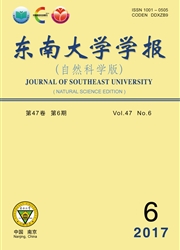

 中文摘要:
中文摘要:
提出了一种基于分子动力学模拟与云模型理论的改进混合蛙跳算法(MD—CM—SFLA).该算法将青蛙个体等效成分子,仅考虑最差个体和全局最优个体之间的吸引力,采用一种新的分子间作用力来代替两体间经典的Lennard-Jones作用力,并利用Velocity-Verlet算法和正态云发生器代替混合蛙跳算法的更新策略,有效平衡了种群的多样性和搜索的高效性.然后,将MD—CM—SFLA算法与BP神经网络相结合,设计出一种MD-CM—SFLA神经网络,并将其应用于耳语音情感识别中.耳语音情感识别结果表明,MD-CM-SFLA神经网络相对于BP神经网络具有明显的优势,在相同的测试条件下,其平均识别率较BP神经网络提高5.2%.由此表明,利用MD—CM—SFLA算法优化BP神经网络的参数,可以实现BP神经网络的快速收敛,获得较好的学习能力,从而为耳语音情感识别提供一种新思路.
 英文摘要:
英文摘要:
A molecular dynamics simulation and cloud model theory based shuffled frog leaping al- gorithm (MD-CM-SFLA) is proposed. In this algorithm, an individual frog is equivalent to a mo- lecular and only the attractive force between the worst individual and the global best individual is considered. A new intermolecular force instead of the classic two-body Lennard-Jones force is adopt- ed, and the Velocity-Verlet algorithm and a normal cloud generator are substitued for the update strategy of the shuffled frog leaping algorithm ( SFLA). The population diversity and the search effi- ciency are effectively balanced. Then, a MD-CM-SFLA neural network is proposed through combi- ning the MD-CM-SFLA with back propagation (BP) neural network, and it is applied to the whis- pered speech emotion recognition. The experimental results of whispered speech emotion recognition indicate that compared with BP neural network, the MD-CM-SFLA neural network has obvious ad- vantages. Under the same test conditions, the average recognition rate of the MD-CM-SFLA neural network is 5.2% higher than that of BP neural network. Therefore, utilizing MD-CM-SFLA algo- rithm to optimize the parameters of BP neural network can obtain fast convergence velocity and good learning ability, thus providing a new idea for whispered speech emotion recognition.
 同期刊论文项目
同期刊论文项目
 同项目期刊论文
同项目期刊论文
 Chaos synchronization of fractional order time-delay Chen system and its application in secure commu
Chaos synchronization of fractional order time-delay Chen system and its application in secure commu Sound Source Localization of Digital Hearing Aids Using Wavelet Based Multivariate Statistical Metho
Sound Source Localization of Digital Hearing Aids Using Wavelet Based Multivariate Statistical Metho Acoustic feedback cancellation based on weighted adaptive projection subgradient method in hearing a
Acoustic feedback cancellation based on weighted adaptive projection subgradient method in hearing a Blind Multiple Access Interference Suppression Algorithm Based on Relaxed Subgradient Projection for
Blind Multiple Access Interference Suppression Algorithm Based on Relaxed Subgradient Projection for Two-dimensional canonical correlation analysis and its application in small sample size face recogni
Two-dimensional canonical correlation analysis and its application in small sample size face recogni 期刊信息
期刊信息
